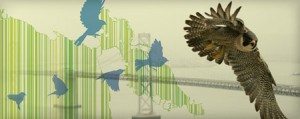San Francisco Mayor Approves New Standards for Bird-Safe Buildings
(Washington,D.C.andSan Francisco,CA, October 11, 2011) American Bird Conservancy (ABC) and Golden Gate Bird Alliance hailed the signing into law of new Standards for Bird Safe Buildings by San Francisco Mayor Edwin Lee. The signing follows the unanimous approval of the bill by the San Francisco Board of Supervisors last month.
The Standards will greatly reduce bird deaths and injuries resulting from collisions with buildings in the city. They include sections on safer windows, night lighting, and the construction of wind turbines in the urban environment.
“Protecting and helping birds is not only the right thing to do, it is also good for the economy and the future of our environment. Birds are invaluable as controllers of crop insect pests, pollinators of plants, and seed distributors; they also generate tremendous economic revenues through the pastimes of bird feeding and birdwatching. We need to do what we can to protect them,” said Eric Mar, the San Francisco Board of Supervisors’ member who sponsored the legislation.
“Mayor Lee and the San Francisco Board of Supervisors are showing national leadership on this critical wildlife issue. Up to one billion birds die each year in building collisions nationwide.San Franciscois acting responsibly by helping to reduce those preventable deaths,” said Dr. Christine Sheppard, manager of ABC’s Bird Collisions Campaign.
“Bird deaths from building strikes, one of the main causes of bird mortality in theUnited States, can often be prevented with reasonable, affordable measures such as those described in these standards. The City ofSan Francisco’s Standards for Bird Safe Buildings constitutes a huge step forward in mitigating this problem in the bay area,” said Mark Welther, Executive Director of Golden Gate Bird Alliance.
Reduction of bird strikes with new buildings can be achieved with simple and cost-effective means. For example, fritting – the placement of ceramic lines or dots on glass – is often already used to reduce air conditioning costs by lowering heat gain in windows. If fritting is applied in particular patterns, it increases the visibility of the window to birds and reduces the likelihood of impacts, while still permitting people to see out clearly from the inside of the building.
The guidelines also address the effects of light pollution, which can confound birds’ ability to navigate by the stars during migration. Lighted buildings and towers can draw birds off course and result in exhaustion, injury, or death for millions every year. The guidelines will reduce unnecessary interior and exterior lighting during the bird migratory seasons, reducing risks to birds.
Bird-safe measures often have other benefits for building owners and operators. For example, fritting reduces heat gain through windows and decreases cooling costs. Turning off unnecessary lights can save owners and operators thousands of dollars a year while greatly reducing risks to birds.
“There are a number of buildings inSan Francisco, such as theSan FranciscoFederalBuildingand the De Young Museum, that are, albeit unintentionally, already bird-friendly. Where new construction is concerned, the bird-friendly options need not be more expensive, since bird-safe materials and designs can be incorporated from the beginning,” Sheppard said.
While San Francisco is looking at this issue on a local level, Illinois Congressman Mike Quigley has introduced national legislation into the federal House of Representatives (HR 4797) that calls for each public building constructed, acquired, or altered by the General Services Administration (GSA) to incorporate, to the maximum extent possible, bird-safe building materials and design features. The legislation would require GSA to take similar actions on existing buildings, where practicable. The terms “bird-safe building materials and design features” are defined through reference to several publications addressing those topics.
Copies of the San Francisco Standards are available online at: http://bit.ly/qwXeYe
Click here to learn more about bird collisions with buildings!
October 11, 2011 press release can be found here
Golden Gate Bird Alliance supports the Standards for Bird Safe Buildings in San Francisco.
Why Have Standards for Bird Safe Building in San Francisco?
– Several hundred million birds die each year in North America from collsions with windows in buildings, especially with “plate” and reflective glass.
– Risks of collisions with tall structures can occur during fog and storms- conditions often seen in San Francisco during the spring and fall migrations.
– San Francisco is part of the Pacific Flyway, where 400 species of birds have been documented.
– Structures in the City put local and migrating birds at risk from collisions.
– Observers have reported death and injury from collisions to Peregrine Falcons, White-crowned Sparrows, Green Herons, Dark-eyed Juncos, and Orange-crowned Warblers and others.
What do the Standards call for?
– Voluntary efforts to reduce risks to birds by including bird-safe measures in design and operations.
– Requirements are limited to a few areas noted as high risk for birds (adjacent to the Bay or in heavily vegetated areas), with a focus on the lower 60’ of structures.
– Use of new and old technologies, from pulling down window shades to safer forms of glass that are becoming more readily and economically available
On September 12, 2011 the San Francisco Land Use Committee Supervisors approved the Standards for Bird Safe Buildings in San Francisco. Supervisors Malia Cohen, Eric Mar and Scott Weiner approved the Standards which will next move to be heard by the full Board of Supervisors on Tuesday, September 20, 2011.
In July the American Bird Conservancy (ABC) and Golden Gate Bird Alliance hailed the passage by the San Francisco Planning Commission of new Bird Safe Building Standards Thursday evening. Read the full press release here.
Read an article in the NY TImes about the issue.

